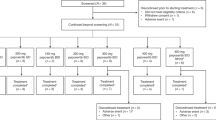Summary
Brequinar sodium (DUP 785, NSC 368390) is a novel quinoline-carboxylic acid derivative that has been selected for clinical evaluation because of its broad spectrum of antitumor activity in animal models and its novel chemical structure. This compound inhibits the mitochondrial enzyme dihydroorotate dehydrogenase (DHO-DH), which catalyzes the conversion of dihydroorotate to orotate, leading to a blockage in the pyrimidine de novo biosynthesis. A total of 43 patients received 110 courses of Brequinar sodium by short-term intravenous (i. v.) infusion, which was repeated every 3 weeks. Dose escalation was initially based on a modified Fibonacci scheme. After pharmacokinetic data from mice and man became available, a pharmacologically guided dose escalation was used; at toxic levels, dose escalation was applied on the basis of clinical judgement. The dose-limiting toxicities were myelosuppression, mucositis, skin rash, nausea and vomiting. The maximum tolerable doses for poor- and good-risk patients were 1,500 and 2,250 mg/m2, respectively. One mixed response was observed in a patient with papilary carcinoma of the thyroid. The recommended doses for phase II studies are 1,200 and 1,800 mg/m2 Brequinar sodium, given by a 1-h i.v. infusion every 3 weeks to poor- and good-risk patients, respectively.
Similar content being viewed by others
References
Carroll DS, Gralla RJ, Kemeny NE (1980) Phase II evaluation ofN-(phosphonacetyl)-l-aspartic acid (PALA) in patients with advanced colorectal carcinoma. Cancer Treat Rep 64:349–351
Chen SF, Ruben RL, Dexter DL (1986) Mechanism of action of the novel anticancer agent 6-fluoro-2-(2′-fluoro-1-1′-biphenyl-4-yl)-3-methyl-4-quinoline carboxylic acid sodium salt (NSC 368390): inhibition of de novo pyrimidine nucleotide biosynthesis. Cancer Res 46:5014–5019
Collins JM, Zaharko DS, Dedrick RL, Chabner BA (1986) Potential role of preclinical pharmacology in phase I trials. Cancer Chemother Pharmacol 21:31–34
Dexter DL, Hesson DP, Ardecky RJ, Rao GV, Tippett DL, Dusak BA, Paull KD, DeLarco BM, Narayanan VL, Forbes M (1985) Activity of a novel 4-quinoline carboxylic acid, NSC 368390, [6-fluoro-2-(2′-fluoro-1-1′-biphenyl-4-yl)-3-methyl-4-quinoline carboxylic acid sodium salt] against experimental tumors. Cancer Res 45:5563–5568
EORTC Pharmacokinetics and Metabolism Group (1987) Pharmacokinetically-guided dose escalation in phase I clinical trials. Commentaries and proposed guidelines. J Cancer Clin Oncol 23:1083–1087
Hart DD, Ohnuma P, Holland JF (1980) Initial clinical study withN-(phosphonacetyl)-l-aspartic acid (PALA) in patients with advanced cancer. Cancer Treat Rep 64:617–624
Peters GJ, Sharma SL, Laurensse E, Pinedo HM (1987) Inhibition of pyrimidine de novo synthesis by DUP 785 (NSC 368390). Invest New Drugs 5:235–244
Scheithauer W, Moyer MP, Clark GM, Von Hoff DD (1988) Application of a new preclinical drug screening system for cancer of the large bowel. Cancer Chemother Pharmacol 21: 31–34
Schwartsmann G, Van der Vijgh WJF, Klein I, Dodion P, Bokkel Huinink WW ten, Winograd B, Gall H, Vermorken JB, Pinedo HM (1987) Pharmacokinetics of DUP 785 in patients with solid tumors receiving short-term intravenous infusion. Proc Eur Conf Clin Oncol 4:75
Schwartsmann G, Peters GJ, Laurensse E, Waal FC de, Loonen AH, Leyva A, Pinedo HM (1988) DUP 785 (NSC 368390): schedule-dependency of growth-inhibitory and antipyrimidine effects. Biochem Pharmacol 37:3257–3266
Van Hennik MB, Van der Vijgh WJF, Klein I, Elferink F, Vermorken JB, Winograd B, Pinedo HM (1987) Comparative pharmacokinetics of cisplatin and three analogs in mice and man. Cancer Res 47:6297–6301
Van Hennik M, Van der Vijgh WJF, Schwartsmann G, Lankelma J, Vermorken JB, Pinedo HM (1987) Comparative pharmacokinetics of cytostatics in mice and man. Proc Eur Conf Clin Oncol 4:77
Author information
Authors and Affiliations
Additional information
This study was done within the framework of the Early Clinical Trials Group (ECTG) of the European Organization for Research and Treatment of Cancer (EORTC) and was partly supported by grant IKA 86-3 from the Dutch Cancer Foundation (Koningin Wilhelmina Fonds). G. Schwartsmann is the recipient of a grant frorm the Post-Graduate Educational Federal Agency (CAPES), Ministry of Education of Brazil
Rights and permissions
About this article
Cite this article
Schwartsmann, G., Dodion, P., Vermorken, J.B. et al. Phase I study of Brequinar sodium (NSC 368390) in patients with solid malignancies. Cancer Chemother. Pharmacol. 25, 345–351 (1990). https://doi.org/10.1007/BF00686235
Received:
Accepted:
Issue Date:
DOI: https://doi.org/10.1007/BF00686235




